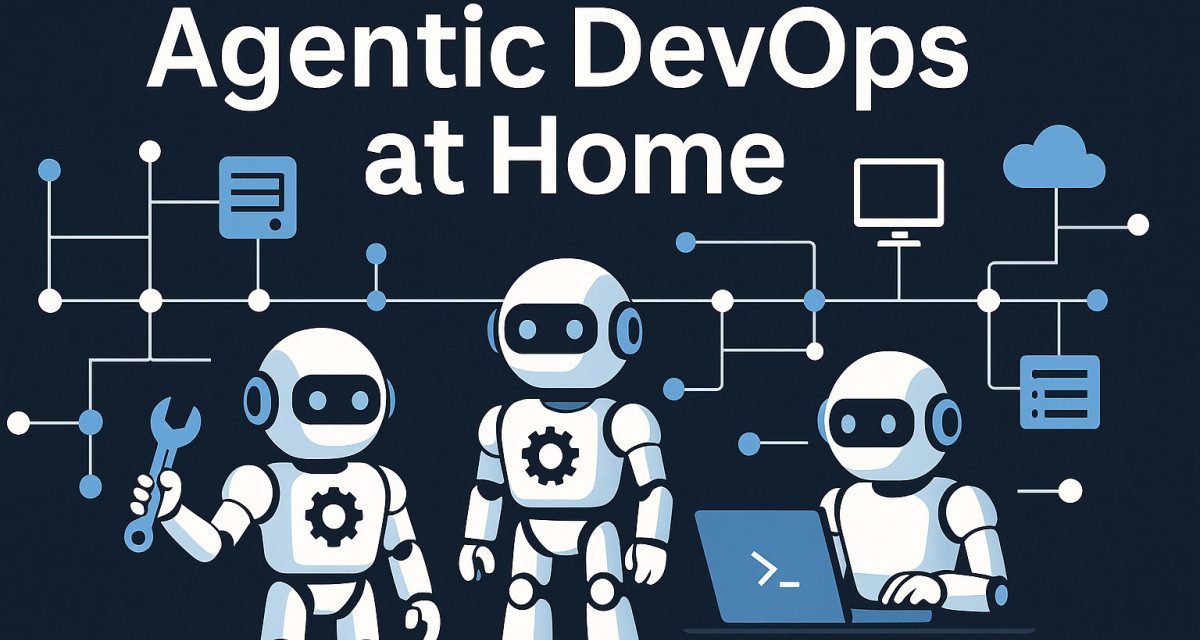Agentic DevOps at Home: An Enterprise-Grade, Open-Source Blueprint for Solo Developers
You can run an enterprise-level platform in your homelab that accepts a simple message in Slack and ships a real app to a public domain. This post lays out a high-level, vendor-neutral map with open-source options at every layer, the tradeoffs, and how agentic tooling fits without sacrificing safety. No install steps here. Just the blueprint and decision tables.
The Agentic Idea
Describe outcomes in plain language. Agents plan, code, test, and open pull requests. Your CI and policies enforce quality. Production changes only land through Git and approvals. The agent is a junior engineer with narrow, auditable powers; Git is the source of truth; CI is the gatekeeper.
End-to-End Reference Flow
[Slack / Telegram / SMS] → [Orchestrator] → [Planner Agent]
→ [Scraper Agent] → [Code Agent] → [DevOps Agent] → [QA Agent]
→ Git PRs → [CI/CD] → [PaaS/Kubernetes] → [DNS/TLS] → Public URL
↘ [Observability] ↘ [Secrets/Policy] ↘ [Audit/Logs]
Slack as a trigger: Slash commands or bot messages kick off runs, post plan diffs, preview links, and approval buttons. Slack is the cockpit, not the deployer. It opens PRs or approves gates, never mutates production directly.
Foundation: Hypervisor, OS, Network
Hypervisor and Private Cloud
- Proxmox VE: Lean VM and LXC, ZFS, clustering, backups. Great default for homelabs.
- Harvester (SUSE/Rancher): Kubernetes-native hyperconverged platform.
- OpenStack: Full private cloud with multi-tenant networking, images, volumes. Heavy, very capable.
- OpenNebula: Lighter private cloud alternative to OpenStack.
Node OS for Kubernetes
- Talos: Immutable, API-managed OS for Kubernetes. Excellent for GitOps and security.
- Ubuntu/Debian: Flexible, familiar, great for utility nodes and custom drivers.
Network and Zero-Trust Access
- Firewall: pfSense or OPNsense with VLANs for control, apps, and observability.
- Zero-trust: Tailscale SaaS or self-hosted Headscale. Open-source alternatives include Nebula and Netmaker on WireGuard.
- Routing and virtual networking: VyOS for advanced routing and BGP in homelabs.
| Layer | Open-source options | Pros | Cons |
|---|
| Hypervisor | Proxmox | Simple, stable, ZFS, snapshots | Not a full cloud API |
| Private Cloud | OpenStack, OpenNebula | Multi-tenant, rich APIs | Operational complexity |
| K8s Node OS | Talos | Immutable, API only, secure | No SSH, steeper learning curve |
| K8s Node OS | Ubuntu/Debian | Flexible, familiar | More drift risk |
| Zero-trust | Headscale, Nebula, Netmaker | Self-host, no seat cost | DIY maintenance |
Compute Orchestration and PaaS
Container Orchestration
- k3s: Lightweight Kubernetes that runs well on Proxmox VMs.
- OKD (OpenShift upstream): Enterprise features on an open base.
Platform Layer
- Coolify or CapRover: Self-hosted PaaS over Docker. Fastest way to ship apps and managed Postgres, Redis, MinIO, Qdrant.
- ArgoCD on Kubernetes: GitOps engine for production-style workflows.
- Cloud Foundry Community or Deis/Helm-based stacks: Traditional open PaaS options, less common today but still viable.
| Category | Open-source options | Pros | Cons |
|---|
| Orchestrator | k3s, OKD | Scalable, portable, ecosystem | Steeper than single-node Docker |
| PaaS speed | Coolify, CapRover | One-click DBs, quick SSL | Single-node limits without extra work |
| PaaS enterprise | ArgoCD + Helm | GitOps, drift correction | Requires k8s familiarity |
Triggers, Orchestration, and Agents
Triggers
- Slack: Slash commands, interactive buttons for approvals, notifications for plans and preview links.
- Alternatives: Matrix, Mattermost, Rocket.Chat for open-source chat. Telegram or SMS for simple ingress.
Workflow Orchestrators
- Temporal: Code-first typed workflows with retries, signals, and long-running reliability.
- Zeebe engine (Camunda 8 OSS): BPMN diagrams and scalable workers.
- Netflix Conductor: JSON DSL, microservice orchestration.
- Argo Workflows: Kubernetes-native workflows as CRDs.
- Flyte, Dagster: Typed data and ML pipelines.
Code and DevOps Agents
- Claude Code or OpenCode for coding inside devcontainers.
- OpenHands or OpenDevin for autonomous edits in sandbox repos.
- MCP servers to expose narrow, typed tools like git, Helm, OpenTofu, kubectl, Cloudflare, Proxmox, without raw shells.
| Orchestrator | Pros | Cons | Best fit |
|---|
| Temporal | Typed, durable, signals, rollouts | Runs its own services and DB | End-to-end agentic DevOps with human gates |
| Zeebe | BPMN auditability, scale | More ceremony | Compliance-heavy or diagram-first teams |
| Conductor | Flexible workers, JSON graphs | More glue code | Microservice orchestration |
| Argo Workflows | K8s-native, simple ops | Typing up to you | Containerized jobs in cluster |
| Flyte/Dagster | Strong typing for data/ML | Infra deploys are secondary | Data pipelines and evaluation loops |
CI/CD, GitOps, and Infrastructure as Code
Infrastructure as Code
- OpenTofu/Terraform: Broad provider ecosystem for Proxmox, Kubernetes, Helm, Cloudflare, GitHub, Tailscale.
- Crossplane: Manage infra as Kubernetes CRDs for a single control plane.
- Pulumi: IaC in TypeScript, Python, Go.
- OpenStack Heat: If you run OpenStack and want native templates.
GitOps and Continuous Delivery
- ArgoCD or FluxCD: Sync cluster state from Git and reconcile drift.
- Atlantis: PR-driven plan and apply for Terraform/OpenTofu.
- Tekton, Jenkins, GitLab CI: Open CI engines if you prefer self-hosting over GitHub Actions.
- Spinnaker: Advanced multi-cloud delivery, heavier footprint.
| Category | Open-source options | Pros | Cons |
|---|
| IaC | OpenTofu/Terraform | Deterministic plan, huge provider set | State management, learning HCL |
| IaC in k8s | Crossplane | Single control plane | Designing compositions adds work |
| Delivery | ArgoCD, FluxCD | Declarative, drift repair | Requires Git discipline |
| CI | Tekton, Jenkins, GitLab CI | Self-host, flexible | Maintenance burden |
| Plan/apply | Atlantis | PR approvals before apply | Terraform-focused |
Data, Storage, Messages, and DNS/TLS
- Databases: Postgres with pgBackRest. Add TimescaleDB for time series.
- Object storage: MinIO for artifacts and static sites.
- Block/cluster storage: Ceph, Longhorn, or OpenEBS on Kubernetes.
- Messaging: NATS, RabbitMQ, or Kafka for events between agents and services.
- DNS/TLS: CoreDNS inside the cluster, cert-manager for ACME, Caddy or Traefik for smart TLS. For public DNS, many use Cloudflare API even though it is not open source. Bind or NSD are open but less convenient for automated public DNS.
| Category | Open-source options | Pros | Cons |
|---|
| Object storage | MinIO | S3-compatible, fast | Plan capacity and redundancy |
| Cluster storage | Ceph, Longhorn, OpenEBS | HA volumes, snapshots | Operational complexity varies |
| Messaging | NATS, RabbitMQ, Kafka | Loose coupling, async | New ops surface area |
| TLS | cert-manager, Caddy, Traefik | Auto-TLS, ingress features | Ingress tuning required |
Security, Identity, Secrets, and Policy
- SSO: Keycloak, Authentik, or Authelia for OIDC across internal apps and dashboards.
- Secrets: Mozilla SOPS with age keys in Git, External Secrets Operator to project into clusters. HashiCorp Vault OSS core if you need dynamic secrets.
- Policy: OPA Gatekeeper or Kyverno for Kubernetes. tfsec or Checkov for IaC scanning. Conftest for custom rules. Falco for runtime detection.
- Network segmentation: VLANs for control plane, app plane, and observability. Deny-by-default egress policies for scrapers and agents.
| Category | Open-source options | Pros | Cons |
|---|
| SSO | Keycloak, Authentik, Authelia | Centralize identity | SSO ops and UX to tune |
| Secrets | SOPS, External Secrets, Vault | Git-friendly or dynamic secrets | Key management complexity |
| Policy | OPA, Kyverno, tfsec, Checkov | Prevents risky changes | Rule authoring required |
| Runtime | Falco | Runtime anomaly detection | Tuning to reduce noise |
Observability
- Prometheus, Grafana, Loki, Tempo, Jaeger for metrics, logs, and traces.
- OpenTelemetry for consistent instrumentation across agents and services.
- Alert to Slack with runbook links in Notion or an open-source wiki like Outline.
| Stack | Pros | Cons |
|---|
| Prometheus + Grafana + Loki | Mature, Kubernetes-friendly | Storage planning and dashboards take time |
| OpenTelemetry + Jaeger/Tempo | Unified tracing across services | More moving parts |
The Agentic Loop With Slack as the Front Door
- You post in Slack: “Build a directory of top coffee roasters with region and roast filters. Ship to roasters.example.com.”
- The orchestrator creates a typed plan with tasks and acceptance checks. The plan is committed to Git.
- Agents scrape sources, generate code, write tests, and open PRs using MCP tools with narrow permissions.
- CI builds images, runs tests and Lighthouse, and posts a preview URL and a Terraform plan back to Slack.
- You approve in Slack. Atlantis applies infra, ArgoCD reconciles the app, CoreDNS and cert-manager handle service and TLS, and Cloudflare or your DNS updates externally.
- Grafana dashboards and logs confirm health. A short post-deploy note is added to your PRD in Notion or an open-source wiki.
Two Practical Starting Paths
Fastest path to shipping
- Proxmox
- One Docker host with Coolify for apps and databases
- Slack triggers into n8n
- OpenTofu for DNS and baseline infra
- GitHub Actions for CI, preview URLs
Enterprise-style at home
- Proxmox or OpenStack for compute
- Talos + k3s or OKD
- ArgoCD for GitOps, Atlantis for plan/apply
- Temporal as the typed orchestrator
- SOPS, External Secrets, OPA/Kyverno, Falco
- Prometheus, Loki, Grafana, OpenTelemetry
Security First Principles
- Slack only triggers PRs and approvals. No direct production mutations.
- Agents work inside devcontainers with MCP tool whitelists and path scoping.
- Production changes require green CI and an approved plan.
- Zero-trust access to admin UIs. No public exposure of Proxmox or Kubernetes APIs.
- Namespace quotas, KEDA or Knative for scale to zero, and budget checks in CI.
Closing
Agentic DevOps does not replace discipline. It lets you apply discipline faster. Slack becomes the front door, typed orchestration keeps the process reliable, and GitOps enforces safety. With the open-source options above, you can reach an enterprise-level developer experience at home while keeping cost near zero at idle, and you learn the exact skills employers value.




Recent Comments